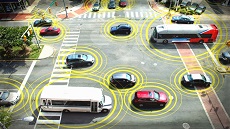
There are changes on the horizon for the auto manufacturing industry, and the thought of this makes many people nervous. After all, despite the continued incorporation of technology into the factories, the auto manufacturing process itself has remained more or less the same over the years. Not to mention the product. While the designs are annually altered with increased horsepower, the concept has not changed at all. This is a comforting fact because the auto industry is married to a booming economy in the minds of many. They were seemingly infallible leading up to 2008, and a symbol of a developed nation. But like I said, there are new and disruptive trends arising that have the power to change the face of the auto industry.
Mobility Sharing
The first of these trends is mobility sharing. Essentially what this means is multiple people sharing a single automobile. This goes beyond many drivers in one family sharing a vehicle, but rather people from different households. This practice would slow the market sales of vehicles but not actually stop them. Exactly how this practice would ultimately play out has still yet to be seen, but the early stages are already evident. Both Beijing and Berlin have small mobility sharing communities that are based on convenience.
It’s been proven through surveys that people prefer driving their own cars rather than calling one through an app or taking a taxi. This combined with the growing expenses of living in a city and practicality of sharing a vehicle point to mobility sharing as a viable option. Of course, it does have its limitations. Someone who commutes regularly would not be able to share easily, as well as people in rural areas who live far from others. There is not yet a blueprint for mobility sharing, but people are expressing more and more interest in the practice.
Self-Driving Vehicles
Self-driving or “automated” cars have been a long-awaited development on the roads. We are finally getting to the point that automated cars will be on the roads in the near future. There are many potential advantages to successfully creating these cars. Drivers would be able to do other productive activities during commutes instead of needing to focus on the road in front of them. They could catch up on work they’re behind on, check in with their families at home, or even have something to eat. Not to mention the potential safety benefits. A tired driver at the end of a long day of work is suddenly no longer a concern.
It’s no wonder that these are highly anticipated machines, but their development requires more than traditional manufacturing. The automated nature requires individuals with programming and computer skill sets, in addition to the engineers. Tech companies and startups are involved in the development process and building of automated vehicles, which is something you would never see in a traditional automobile manufacturing centre. With all that said, there are still some bugs that need to be addressed, but a world full of these machines is not that far in the future. It has been projected that they will be available worldwide by 2030.
Electric Cars
Electric cars and hybrids like the Ford Focus have been available on the market for over a decade now, but never really seemed to gain too much popularity. There are a number of different reasons for this. They have a reputation of not being as powerful as their gas-guzzling counterparts, for instance. But this might change in the coming years. People are increasingly environmentally conscious, and is coinciding with improved electric vehicles. The batteries have improved in the past couple years, as well as a wider infrastructure for charging stations. They are expected to be most commonly adopted in big cities with strict emissions regulations. They also are proving to be a popular choice for shared mobility.
Region Based Cars
There has always been a disparity between the mobility needs of the rural and the urban. The kind of vehicle that is needed in the spacious country with unpredictable roads is very different than the cars sought after in a dense city. Of course, that’s why there are different models of vehicles. They are meant to cater to a wide range of landscapes. These options will only become more pronounced in coming years, as the auto industry are expected to cater to specific regions.






